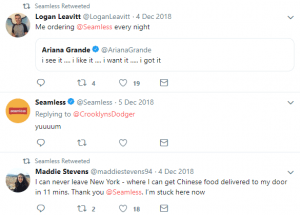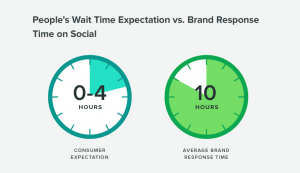Do You Have Your Social Media Marketing Strategy Sorted For 2019?
If you don’t, we do not blame you. Facebook descended into controversy due to its algorithm changes and privacy concerns. All the while, brands became bolder, launching conscious and seemingly controversial campaigns as customers want to watch brands get real.
And that doesn’t even begin to scratch the surface. Last years events combined with this year’s emerging trends have left marketers with a feeling of analysis paralysis.
Where would you go from here? To keep your brand from watching from the sidelines, we’ve broken down the steps to creating a social media marketing strategy to carry you through 2019 with a feeling of purpose.
1. Establish Goals That Tackle Your Greatest Challenges
 First of all, you want to determine what you need out of social media at large. Maybe it’s more social-savvy customers. Perhaps it is a larger share of voice within your industry. Brands should strive to set targets which are actually achievable.
First of all, you want to determine what you need out of social media at large. Maybe it’s more social-savvy customers. Perhaps it is a larger share of voice within your industry. Brands should strive to set targets which are actually achievable.
For example, aiming for a million fresh Instagram followers in 2019 isn’t going to take place. By handling smaller, realistic goals, you can scale your social attempts in a way that’s both reasonable and affordable.
Here are some actionable goals that brands of all shapes and sizes can divide and conquer.
- Boost brand awareness: To create lasting and authentic brand awareness, avoid solely publishing promotional messages. Instead, concentrate on content emphasizes your nature and sets your followers before the tough sell.
- Achieve higher quality sales: Through more effective social targeting, you reach your core audience much faster.
- Drive in-person sales: Many brick-and-mortar companies are on the search for a social media marketing strategy that compels in-store sales. Is your brand-boosting enough on social to lure people to come to see you? Are you about alerting clients to what’s going on in your shops, including promotions and action shots of your shop? Boost ROI. Favorable social websites ROI does not happen by accident. Taking the time to audit your social platforms will help keep the expense of labour, ads, and creatives down.
- Create a loyal fanbase: Does your brand encourage user-generated content? Do your followers react positively with no sort of initiation? Your customers can be your biggest cheerleaders and sources of fresh content, but only as long as you are encouraging them to post for your benefit.
- Better understanding of the industry: What are the competitors doing that seems to be working? What strategies are they employing to drive sales or engagement? Any combination of those explicit goals is fair game and will help you understand which networks to tackle.
2. Research Your Audience
Making assumptions is a dangerous game for entrepreneurs. As a result of its sheer wealth of demographic data and social media analytics tools on the market, you really don’t need to anymore.
So much of everything you want to know about your audience to influence your social media marketing strategy is currently out in the open. Take today’s social networking demographics, for example.
This demographic information isn’t nonsense, either. These numbers speak directly about which networks your brand should approach and what types of content to publish.
- Facebook and Youtube represent great places to run ads.
- The majority of Instagram’s users are under 30, signaling the strength of daring, eye-popping content which oozes with personality.
- Girls hugely outnumber men on Pinterest, which can be noted to boast the highest average order value for social shoppers.
- LinkedIn’s user base is well-educated, Which makes It a hub for in-depth, industry-specific content, which may be more complicated than what you see on Facebook or Twitter.

See how that works?
Even though the demographics data above provides you insight into every channel, what about your customers? Further investigation has to be performed before you can truly know your client demographics on social media.
That is why lots of brands use a social media dashboard, which may offer a synopsis of who’s following you and how they interact with you on every platform. Most manufacturers today are employing at least some sort of dash. But does your dashboard tie in your specific objectives?
Brands ought to be where their target market is hanging out: that is a no-brainer. A strong dashboard can help you double-check that you’re spending some time targeting the proper channels. Whether you’re an agency providing insights for the clientele or an enterprise company discovering your own demographics, an all-in-one dashboard solution is crucial.
3. Establish Your Metrics
 No matter what you’re trying to achieve, your social media marketing strategy should be guided by data. That means focusing on the right social media metrics. What good are millions of followers if you can’t do anything with them?
No matter what you’re trying to achieve, your social media marketing strategy should be guided by data. That means focusing on the right social media metrics. What good are millions of followers if you can’t do anything with them?
Engagement metrics are crucial to building meaningful, lasting relationships with your followers. Massive audiences and likable content are great, but here are some additional tips to keep an eye on in 2019:
- Reach: Post reach is the total number of unique people who saw your post.
How far is the content spreading across social? Is it actually reaching consumer’s feeds? At the face of ever-changing organic calculations, monitoring reach is arguably more important than ever. - Clicks: Here is the number of clicks on anything related to your content and brand. Link clicks are essential in understanding how users move throughout your marketing funnel. Tracking clicks is vital to understand what drives engagement or makes people buy.
- Engagement: The total volume of interactions divided by the amount of impressions. For engagement, it’s about knowing who interacted and when it was a fantastic ratio from your overall reach. This illuminates how well your audience perceives you and also their willingness to socialise.
- Hashtag performance: What were your most used hashtags? Which hashtags were associated with your brand? What hashtags provided the most engagement?
- Organic and paid likes: More than just regular Likes, these are defined from paid or organic content. For channels such as Facebook, organic participation is a lot harder to gain traction, which is why many manufacturers turn to Facebook Ads. However, earning organic likes on Instagram is not quite as difficult.
- Sentiment: This is the measurement of how users responded to your articles, brand or hashtag. Did clients find your latest effort offensive? Which kind of opinion are people associating with your campaign hashtag? It’s always much better to dig deeper and find what folks are saying.
An effective social networking marketing strategy is rooted in numbers. Having said that, those numbers have to be put in context that circles back to your original objectives.
4. Dive Into What Your Competitors Are Doing
Before you start creating content, you ought to have a good idea of what your competitors are up to. Doing so might only require some surface-level investigation. Some brands might also check into third-party competitor analysis tools to dig deeper into their competitors’ numbers.
Looking at the competition’s presence will directly notify your very own social media marketing plan. The goal here is not to copy or directly steal your competitors’ ideas. Instead, it’s to understand what’s working for them and ways to adapt your campaigns.
Same Industry, New Approaches
For example, let’s have a glance at how two brands in precisely the exact same space can take two totally different approaches to their social media marketing strategy. In this case, we will dip in the area of ice cream. Halo Top Cream prioritises their own eye-popping visuals and clever captions to show off their treats. Their articles score tons of engagement on a constant basis.

On the flip side, Ben & Jerry’s takes an entirely different approach to social media. Along with their very own in-house promotional photographs, they pushe a great deal of user-generated content. Perhaps most noteworthy is the fact that Ben & Jerry’s does not shy from posts that stir a great deal fo emotion. Some would argue that politics and ice cream don’t mix, but the brand has generated lots of buzz by placing their worth front-and-center.

The takeaway here is that manufacturers have as much room to set themselves apart from their rivals concerning content and voice. Obviously, you need to understand who your competitors are until you start stressing over content creation.
How To Spot Your Social Competitors
 The easiest way to find competitors is through a simple Google search. For instance, if you sold different soaps, “handmade natural soaps” would be a terrific keyword to research. Ignoring major online retailers like Amazon and Bath & Body Works, take a peek at who is popping up in your area both organically and through advertisements.
The easiest way to find competitors is through a simple Google search. For instance, if you sold different soaps, “handmade natural soaps” would be a terrific keyword to research. Ignoring major online retailers like Amazon and Bath & Body Works, take a peek at who is popping up in your area both organically and through advertisements.
Then, you’re going to want to look at who’s active on social media. In this specific circumstance, Wild Soap is a bigger operation with an active, flourishing social media presence. This means they’re a great option to track.
After gathering a small number of industry competitors, it is wise to use a societal media competitive analysis tool to monitor Facebook and Instagram content. This will clue you in on what tags they’re using and likewise what material they are posting.
As soon as you examine an array of opponents, you’ll have a better idea of what your own audience wants.
5. Create And Curate Engaging Social Content
Your social media marketing strategy is clearly centered around content. At this point, you need to have a fairly good idea about what to publish based on your goal and new identity. Likewise, you likely feel confident by which networks to cover. Still overwhelmed by the particulars of exactly what you should be posting? From picking the correct creatives and captions into finding the balance between personality and promotion, there’s a whole lot to mull over. The pressure is definitely on manufacturers in an age where 46% of consumers say they’ll unfollow a brand that is overly promotional. Additionally, 41 percent of users say they had unfollowed a brand that shared too much irrelevant content.
To help narrow down the particulars of exactly what you ought to be publishing, let us start with 2019’s social tendencies and best practices. Consider any mixture of these since you put together the material part of your social media marketing program.
Video Content Or Bust
The demand for brands to generate video is greater than ever before. Across all of social media, videos are one of the most seen and shared hands-down. Facebook and Instagram, particularly, are pushing video hard right now, which is notable given how their individual algorithms will continue to evolve 2019.
Live? Long-form? Short video? There is no lack of alternatives for brands to play the role of producer these days regardless of your budget.

User-Generated Content
Again, we can not stress enough the significance of curating user-generated articles from branded hashtags. Customers today certainly love authentic content that does not always have that type of professional, polished signature. If nothing else, UGC means less work and not as much pressure to constantly be thinking of new content ideas.
Build Content Themes
One of the hardest challenges to visual content is making it on a day-to-day basis. A Venngage infographic showed 36.7% of entrepreneurs said their top battle with creating visual content was doing so consistently. This shows how significant highly-visual content will be to marketers as well as the folks they wish to attain. That’s why building content topics is a great approach to sectioning out of your own content.
6. Make Timeliness A Top Priority
 Let’s start with the first point. Social media channels are constructed as networks. Your brand can not overlook these core elements of “networking.” It takes effort to ensure discussions or participation chances aren’t left unattended.
Let’s start with the first point. Social media channels are constructed as networks. Your brand can not overlook these core elements of “networking.” It takes effort to ensure discussions or participation chances aren’t left unattended.
Through social networking, you earn respect as a brand by just being present and speaking to your audience. That is why social customer care is indeed important to manufacturers attempting to increase audience awareness. It is all about participation. For instance, Seamless does a superb job of not just responding but showing customer care is a high priority. During the right social media monitoring tools, it is possible to find instances across all your channels to interact, respond, and gauge customer support queries. Designating teams to certain tasks can aid your employees to run as a self-study social media team, whether you’re a group of one or 100.
The Best Times To Post
 When is your brand most accessible to participate and interact with clients? You might see some recommended times to post late in the day, for instance. However, if your brand is not there to communicate, what’s the purpose of posting in the “preferred” period? Instead, try to safeguard your social websites or community supervisors are available and ready to answer any product questions or concerns when you tweet or post. It’s smart to learn that the best times to article on social media, but it is equally as crucial to participate after submitting.
When is your brand most accessible to participate and interact with clients? You might see some recommended times to post late in the day, for instance. However, if your brand is not there to communicate, what’s the purpose of posting in the “preferred” period? Instead, try to safeguard your social websites or community supervisors are available and ready to answer any product questions or concerns when you tweet or post. It’s smart to learn that the best times to article on social media, but it is equally as crucial to participate after submitting.
In accordance with our Index, a brand’s average reaction time is around 10 hours. But were you aware that many users believe brands must react to social media messages in under four hours? The updated algorithms means organic content has a difficult time reaching the majority of your viewers. The very last thing you want to do is dismiss those that engage and lose out on sending down your marketing funnel.
7. Assess What Is Working, What Isn’t, And How You Can Enhance.
However, it’s important that you’re ready to adapt your plan as you progress through the year. Without continuously analyzing your efforts, you will not ever understand how one effort did over a second. This means looking at your top-performing content and fine-tuning your efforts accordingly. There is no denying that a lot of social media is a matter of trial-and-error.
Tracking the metrics behind your campaigns in real-time permits you to make modest tweaks to your social media marketing strategy instead of sweeping, time-consuming alterations. This dynamic approach to digital marketing makes perfect sense in a day and age where social media is continuously evolving. Hopefully, this breakdown functioned as some much-needed inspiration and guidance for reaching your social aims for this year.
Ready to create your own social media marketing strategy? Simply download load our free, step-by-step template to get you started.









